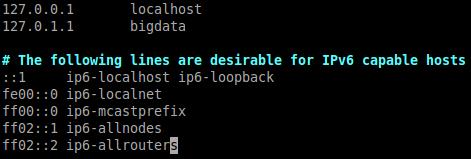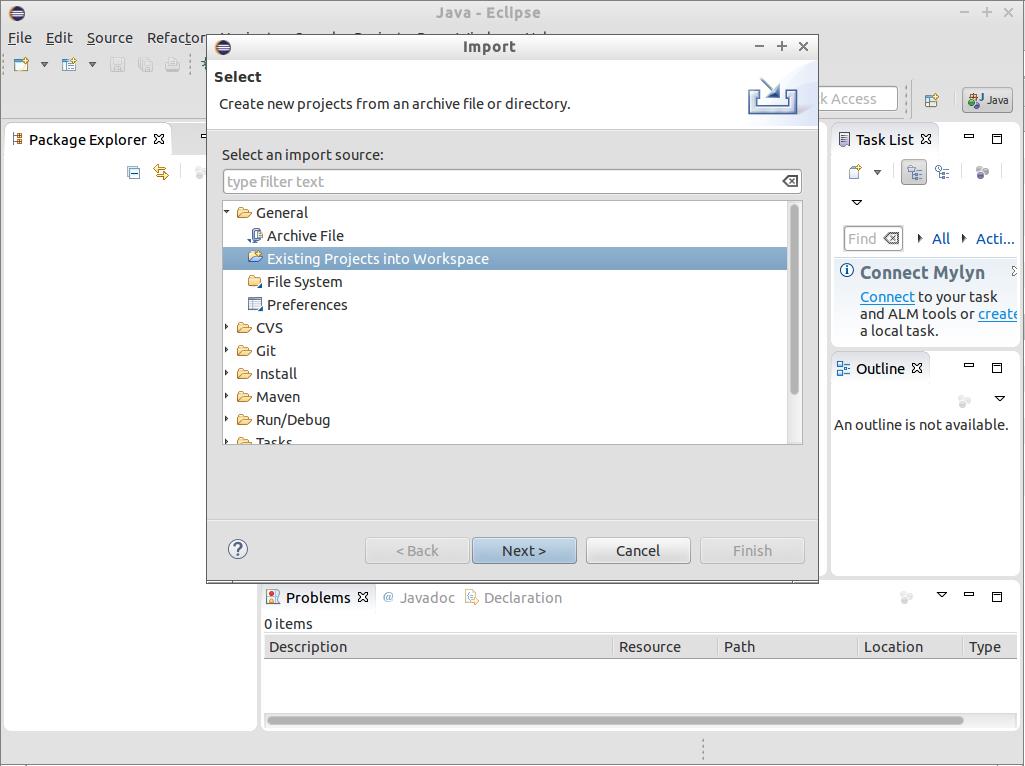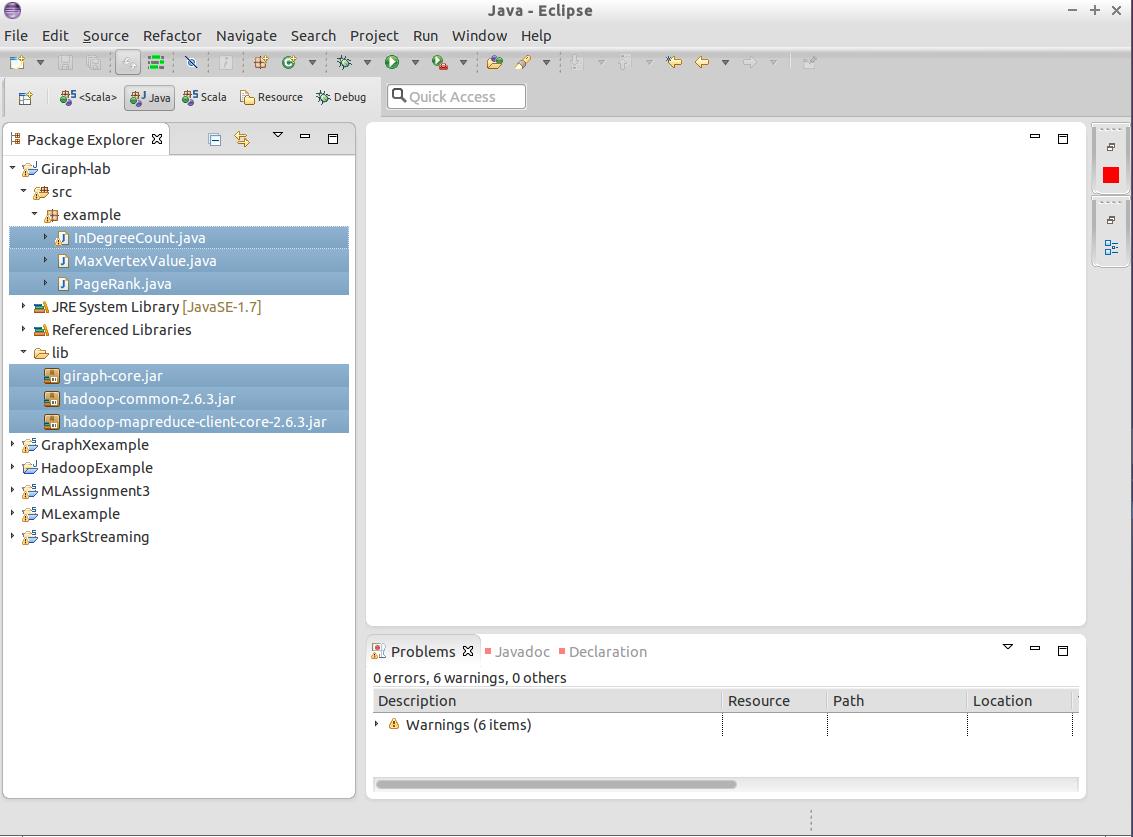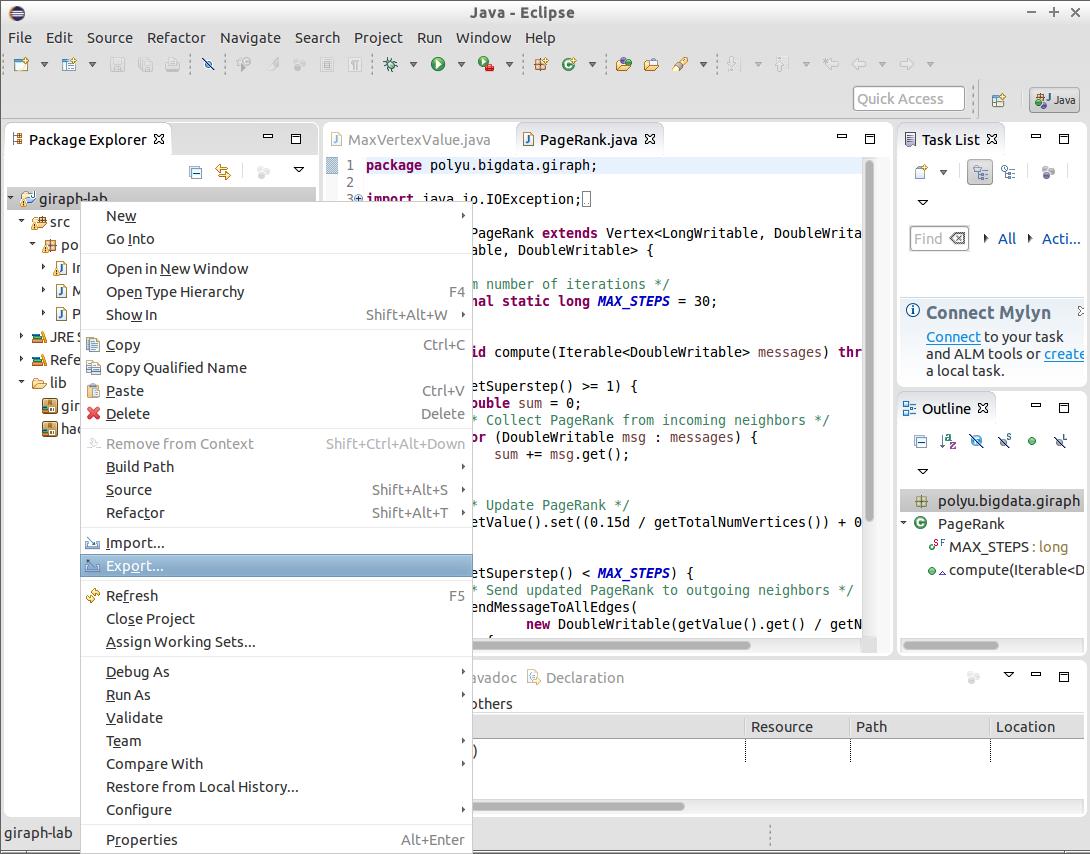Hello Giraph
Posted AlexP5
tags:
篇首语:本文由小常识网(cha138.com)小编为大家整理,主要介绍了Hello Giraph相关的知识,希望对你有一定的参考价值。
转载自:http://www.cse.cuhk.edu.hk/~ericlo/teaching/bigdata/lab/9-Giraph/#execute
Introduction
Apache Giraph is an open-source and distributed graph processing system based on Google's Pregel. It adopts vertex-centric programming model and is implemented by re-using Hadoop MapReduce code base.
In this lab, we will teach you
Installing Giraph
Installing Giraph library
Please start up your virtual box and download the prepared Giraph libaray JAR giraph-core.jar .After that, copy giraph-core.jar to ~/Programs/hadoop/share/hadoop/common/ .
Dealing with Giraph's Bug
Giraph jobs were consistently hanging if the hostname includes uppercase letters (which is a known bug). Say if you are using our VirtualBox image, you need to
- using sudo vim /etc/hostname to change the content of the file /etc/hostname from

to
- using sudo vim /etc/hosts to change the content of the file /etc/hosts from

to
- and restart the image.
Writing Giraph Programs
Similar to developing MapReduce programs, we use Eclipse IDE to implement Giraph programs. Now, download our lab material giraph-lab.zip here and look at some examples.
Import graph-lab.zip to Eclipse: Select File -> Import and choose Existing Projects into Workspace Choose
Select archive file and select
giraph-lab.zip
Choose
Select archive file and select
giraph-lab.zip
 After clicking
Finish, you will see
After clicking
Finish, you will see

After importing the project, you will see 3 Java files in src folder. Also, you will find giraph-core.jar, hadoop-common-2.6.3.jar and hadoop-mapreduce-client-core-2.6.3.jar in lib folder. The first one is the Giraph core library while the other two are Hadoop libraries (you met before in MapReduce Lab).
MaxVertexValue program
Let's have a quick look at MaxVertexValue.java. Its code is shown as below.
package example;
import java.io.IOException;
import org.apache.giraph.graph.Vertex;
import org.apache.giraph.graph.BasicComputation;
import org.apache.hadoop.io.DoubleWritable;
import org.apache.hadoop.io.FloatWritable;
import org.apache.hadoop.io.LongWritable;
/**
Vertex ID: LongWritable
Vertex value: DoubleWritable
Edge value: FloatWritable
Message: DoubleWritable
Assumption:
1. The graph is strongly connected
*/
public class MaxVertexValue extends BasicComputation<LongWritable, DoubleWritable, FloatWritable, DoubleWritable>
@Override
public void compute(Vertex<LongWritable, DoubleWritable, FloatWritable> vertex,
Iterable<DoubleWritable> messages) throws IOException
boolean changed = false;
for (DoubleWritable msg : messages)
/* Collect messages from in-neighbours and update if necessary */
if ( vertex.getValue().get() < msg.get() )
vertex.setValue( new DoubleWritable( msg.get() ) );
changed = true;
/* Send the message to out-neighbours at Superstep 0 or Vertex value is changed */
if ( getSuperstep() == 0 || changed )
sendMessageToAllEdges(vertex, getValue());
vertex.voteToHalt();
To use Giraph's vertex-centric model, your class should extend
org.apache.giraph.graph.BasicComputation<I, V, E, M>
and implement
compute()
method. The meanings of <I, V, E, M> are as follows.
I: Vertex ID
V: Vertex value
E: Edge value (edge weight)
M: Message
I, V, E, M should implement Writable interface in Hadoop API. For example, IntWritable, FloatWritable are valid classes.
An important member function of BasicComputation class is getSuperstep(), which obtains the current step number. Note that it starts from zero.
As an argument of compute() method, vertex with type org.apache.giraph.graph.Vertex<I,V,E> has some useful functions:
- setValue(): Modify the value of a vertex. The new value takes effect immediately after calling this function.
- sendMessageToAllEdges(): Intuitively, this sends a message to all outgoing neighbors. If you send a message to a specific neighbor, you can use sendMessage().
- Superstep 0: A vertex sends its vertex value to its out-neighbours.
- Superstep > 0: Check if the incoming messages are larger than its current value. If so, update its current value and propagate the value to its out-neighbours.
- Output: All vertices have the maximum vertex value in the graph.
PageRank program
PageRank algorithm is used by Google to rank search engine results. PageRank represents the importance of a web page. PageRank algorithm in vertex-centric implementation is as follows, assuming we are given the maximum number of supersteps MAX_STEPS.
package example;
import java.io.IOException;
import org.apache.giraph.graph.Vertex;
import org.apache.hadoop.io.DoubleWritable;
import org.apache.hadoop.io.FloatWritable;
import org.apache.hadoop.io.LongWritable;
import org.apache.giraph.graph.BasicComputation;
public class PageRank extends BasicComputation<LongWritable, DoubleWritable, FloatWritable, DoubleWritable>
/* Maximum number of iterations */
public final static long MAX_STEPS = 30;
@Override
public void compute(Vertex<LongWritable, DoubleWritable, FloatWritable> vertex,
Iterable<DoubleWritable> messages) throws IOException
if (getSuperstep() >= 1)
double sum = 0;
/* Collect PageRank from in-neighbors */
for (DoubleWritable msg : messages)
sum += msg.get();
/* Update PageRank */
DoubleWritable vertexValue =
new DoubleWritable((0.15d / getTotalNumVertices()) + 0.85d * sum);
vertex.setValue(vertexValue);
if (getSuperstep() < MAX_STEPS)
/* Send updated PageRank to out-neighbors */
sendMessageToAllEdges(vertex,
new DoubleWritable(vertex.getValue().get() / vertex.getNumEdges()));
else
/* Stop */
vertex.voteToHalt();
The idea of PageRank:
- Superstep 0: Disseminate vertex's initial value to its out-neighbours
- 0 < Superstep < MAX_STEPS: Update its current PageRank and disseminate the value to its out-neighbours
- Superstep >= MAX_STEPS : All vertices are set to halt for termination
Executing Giraph Programs
Exporting Eclipse project to JAR
Export your project to a JAR with the following settings.
Right the project folder and select Export Select
JAR file and click
Next
Select
JAR file and click
Next
 Uncheck
lib folder, select your output directory and click
Finish
Uncheck
lib folder, select your output directory and click
Finish
 After that, copy your exported JAR
giraph-lab.jar
to
~/Programs/hadoop/share/hadoop/common
. This helps Hadoop to recognize your JAR.
After that, copy your exported JAR
giraph-lab.jar
to
~/Programs/hadoop/share/hadoop/common
. This helps Hadoop to recognize your JAR.
Please download two example graph data files graph-data1.txt and graph-data2.txt.
They have the following format: Each line below has the adjacency-list format [source_id,source_value,[[dest_id,edge_weight],[dest_id,edge_weight],...]].
This format is called JsonLongDoubleFloatDoubleVertexInputFormat. The content of graph-data1.txt is as follows:
[0,100,[[1,1],[3,3]]]
[1,20,[[0,1],[2,2],[3,1]]]
[2,90,[[1,2],[4,4]]]
[3,50,[[0,3],[1,1],[4,4]]]
[4,80,[[3,4],[2,4]]]
For example,
[2,90,[[1,2],[4,4]]]
means Node 2 has vertex value of 90. It has an edge to Node 1 with weight 2 and has another edge to Node 4 with weight 4.
Now, you start Hadoop, upload graph-data1.txt to HDFS and execute your Giraph programs.
# Start Hadoop
$ cd ~/Programs/hadoop/sbin
$ ./start-all.sh
$ cd ../bin
# Note: current directory is ~/Programs/hadoop/bin
# Create folder in HDFS if not exist
$ ./hadoop fs -mkdir -p /user/bigdata/giraph/input
# Upload graph-data1.txt to HDFS, assume it is at ~/
$ ./hadoop fs -put ~/graph-data1.txt /user/bigdata/giraph/input/graph-data1.txt
# Execute Giraph program
$ ./hadoop jar ../share/hadoop/common/giraph-core.jar org.apache.giraph.GiraphRunner example.MaxVertexValue -vif org.apache.giraph.io.formats.JsonLongDoubleFloatDoubleVertexInputFormat -vip /user/bigdata/giraph/input/graph-data1.txt -vof org.apache.giraph.io.formats.IdWithValueTextOutputFormat -op /user/bigdata/giraph/output -w 1 -ca giraph.SplitMasterWorker=false
# Display output file
$ ./hadoop fs -cat /user/bigdata/giraph/output/part-m-00000
Explanation:
- org.apache.giraph.GiraphRunner: A Giraph Job Runner that executes any BasicComputation class.
- -vif: specifies the vertex input format, i.e., how to read the graph file. JsonLongDoubleFloatDoubleVertexInputFormat is one of the built-in input formats.
- -vof: specifies the vertex output format, i.e., how to write the output. IdWithValueTextOutputFormat is one of the built-in output formats, which results in <VertexID, VertexValue> format line by line.
- -vip/-op: Input/output paths.
- -w: Number of workers used. A worker is a host that performs the computation and stores data in HDFS. It can either be a physical server or even a virtualized server.
- -ca giraph.SplitMasterWorker=false: We have this setting because our master and worker are in the same node.Remarks: You can define your own input and output formats by extending TextVertexInputFormat and TextVertexOutputFormat in org.apache.giraph.io.formats package.

Executing PageRank
Let's upload graph-data2.txt to HDFS and execute PageRank. The expected output is as follows.

Exercise
- Write a Giraph program that computes the in-degree of each vertex.
Code Snippet 1: sendMessage(edge.getTargetVertexId(), new DoubleWritable(1.0)); |
Code Snippet 2: sum++; |
以上是关于Hello Giraph的主要内容,如果未能解决你的问题,请参考以下文章